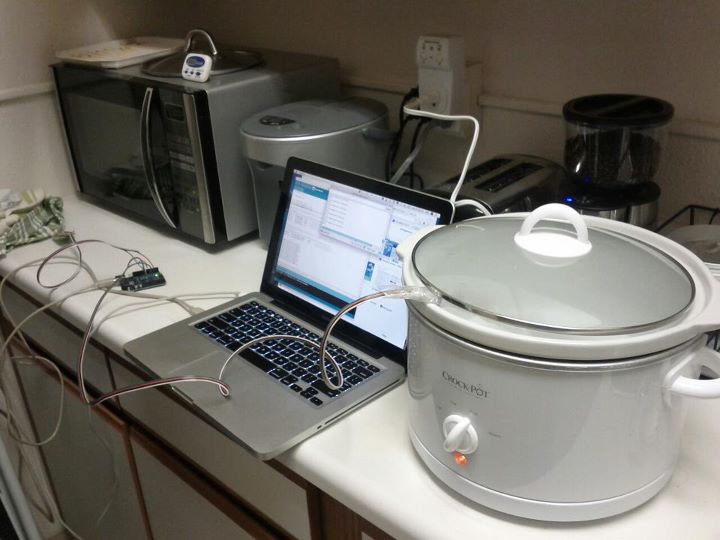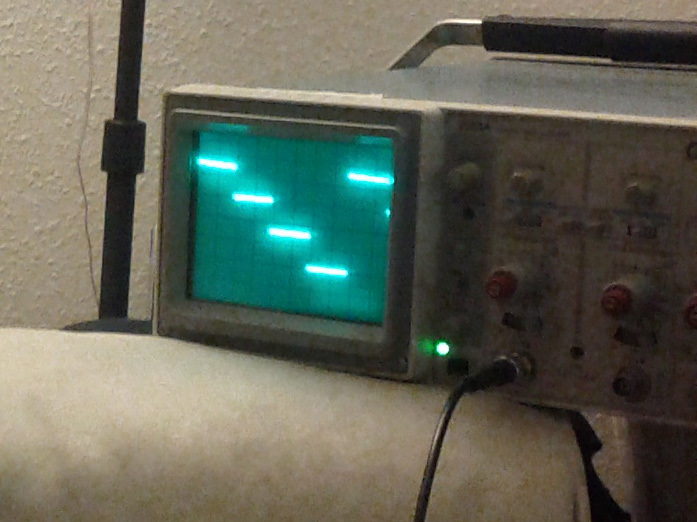Notes from Homemade Sous Vide
I decided that I wanted to try sous vide this weekend, and didn’t want to wait to order a PID controller in the mail. My thought was that I could use a microcontroller with a big relay wired up to the LCD traces for a kitchen thermometer and do the control myself.
I went to Fry’s and purchased a thermometer for $11, a remote controlled appliance switch for $11 and a 6 qt crock pot for $25.

Unfortunately, the LCD display on the thermometer I bought uses some kind of PWM on the pins to multiplex inputs, and that would probably take more than the afternoon to properly reverse engineer:

Fortunately, Gabe had an extra temperature sensor sitting around, so some one wire code later, we got my arduino sampling temperatures. Right now, it uses a simple temperature range to decide when to turn on and off the crock pot, but there’s a handy PID control library for arduino that could probably be used to reduce the overshoot of the current approach (1ºC). Another thing that would be useful to do is to use the arduino ADC to sample the temperature from a thermocouple. There’s some code that does this here.
Since I didn’t have a glue gun on hand to properly isolate the sensor from the water path, it eventually started shorting and producing bad data. Putting it in a plastic bag was a pretty good workaround, but insulating air inside the bag caused the temperature readings to be off by as much as 1ºC, so the system was off by as much as 2ºC at any given time. Putting the exposed wire inside of a glue blob and then heat shrinking around that seems to have fixed the problem, but a thermocouple is probably going to be more accurate and would handle a wider range of temperatures.
The results were pretty tasty, though it looks like 14 hours is insufficient for beef chuck, which was still a little tough, but not too tough. It’s fine for other cuts of meat, such as a flat steak. I ended up pan searing the steaks after I took them out of the bags, but I think I might have not had a hot enough pan to flash sear it and ended up overcooking. Some people recommend that you use a butane torch (propane supposedly leaves more of an off taste) to get around this problem.
On the note of putting it in a bag, I ended up using a ziplock freezer bag and then dipped it in the water with the bag open to push out excess air, though I think a vacuum sealer would work better.
Lessons Learned:
- Crock pots tend to overshoot, but are probably safer if you’re building your own control system. Consider a rice cooker or other simple steamer that can be externally switched because those have less thermal inertia, and you don’t want another control system interfering with turning it on and off externally.
- A simple on/off with a cheap remote wall switch works surprisingly well. I was able to drive the remote control for the appliance relay with a digital high on the microcontroller.
- You don’t necessarily need PID control, but it probably would keep the temperature more stable. You can buy one on Amazon, though you’ll want to buy a thermocouple (probably type K) to go with it.
- You don’t necessarily need a crock pot. You could also use an immersion heater to warm the water.
- 132ºF is probably a good temperature for medium rare with sous vide with this system